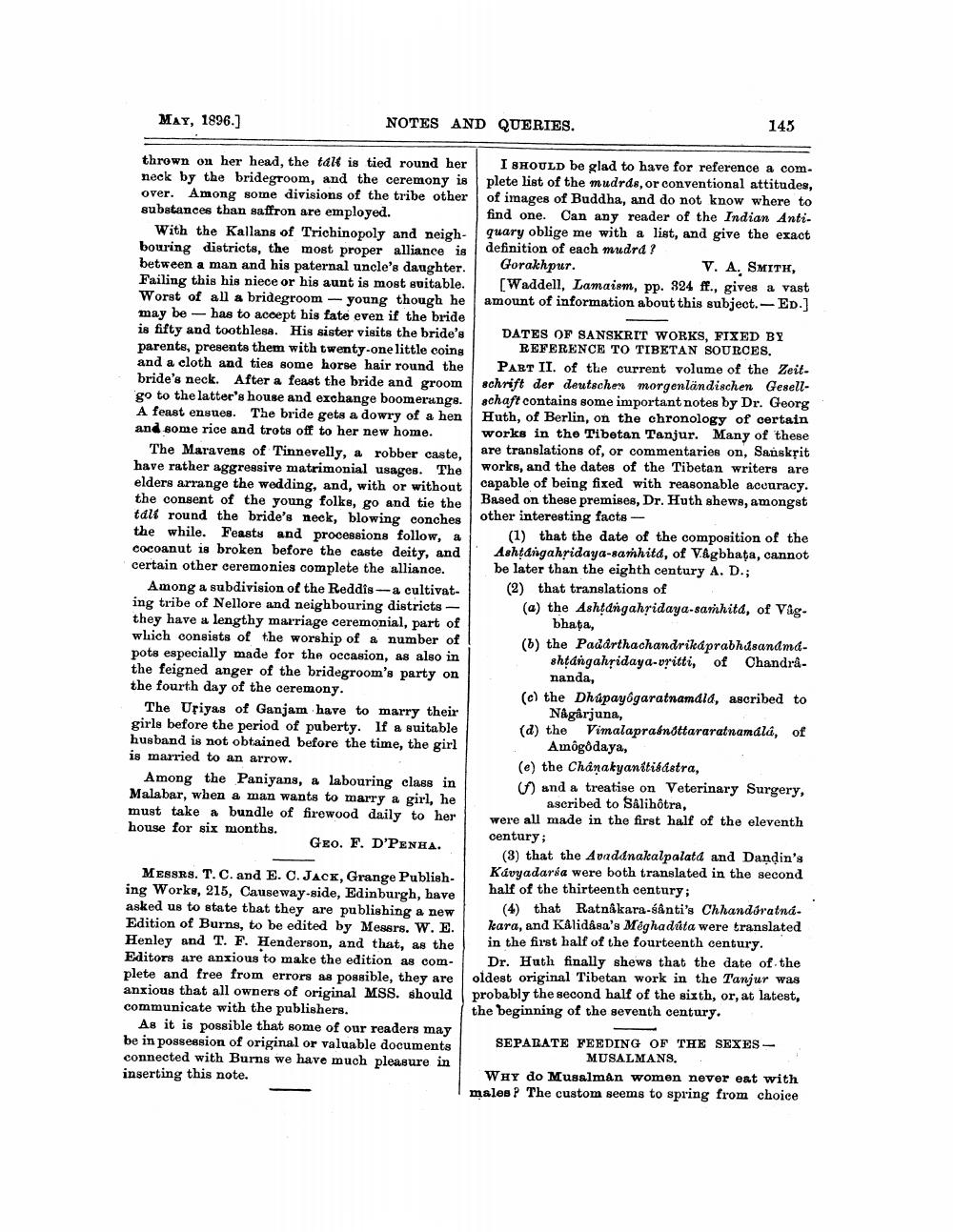________________
May, 1896.)
NOTES AND QUERIES.
145
thrown on her head, the talk is tied round her I SHOULD be glad to have for reference a com. neck by the bridegroom, and the ceremony is plete list of the mudrds, or conventional attitudes, over. Among some divisions of the tribe other of images of Buddha, and do not know where to substances than saffron are employed.
find one. Can any reader of the Indian AntiWith the Kallans of Trichinopoly and neigh- quary oblige me with a list, and give the exact bouring districts, the most proper alliance is
definition of each mudrd ? between a man and his paternal uncle's daughter.
Gorakhpur.
V. A. SMITH, Failing this his niece or his aunt is most suitable. | [Waddell, Lamaism, pp. 324 ff., gives a vast Worst of all a bridegroom - young though he amount of information about this subject. -ED.] may be - has to accept his fate even if the bride is fifty and toothless. His sister visits the bride's DATES OF SANSKRIT WORKS, FIXED BY parents, presents them with twenty-one little coing REFERENCE TO TIBETAN SOURCES. and a cloth and ties some horse hair round the PART II. of the current volume of the Zeit. bride's neck. After a feast the bride and groom schrift der deutschen morgenländischen Gesellgo to the latter's house and exchange boomerangs. achaft contains some important notes by Dr. Georg A feast ensues. The bride gets a dowry of a hen Huth, of Berlin, on the chronology of certain and some rice and trots off to her new home. works in the Tibetan Tanjur. Many of these The Maravens of Tinnevelly, a robber caste,
are translations of, or commentaries on, Sanskrit have rather aggressive matrimonial usages. The
works, and the dates of the Tibetan writers are elders arrange the wedding, and, with or without
capable of being fixed with reasonable accuracy. the consent of the young folks, go and tie the
Based on these premises, Dr. Huth shews, amongst tall round the bride's neck, blowing conches
other interesting facts - the while. Feasts and processions follow, a (1) that the date of the composition of the cocoanut is broken before the caste deity, and Ashtangahridaya-samhita, of V&gbhata, cannot certain other ceremonies complete the alliance. be later than the eighth century A. D.;
Among a subdivision of the Reddis-a cultivat- (2) that translations of ing tribe of Nellore and neighbouring districts -
(a) the Ashtdngahridaya-sanhita, of Vagthey have a lengthy marriage ceremonial, part of
bhata, which consists of the worship of a number of (b) the Padarthachandrikáprabhusandmdpots especially made for the occasion, as also in
shtangahridaya-vritti, of Chandrathe feigned anger of the bridegroom's party on
nanda, the fourth day of the ceremony.
(c) the Dhúpayôgaratnamdid, ascribed to The Uriyas of Ganjam have to marry their
Nagarjuna, girls before the period of puberty. If a suitable (d) the Vimalaprasnottararatnamdlá, of husband is not obtained before the time, the girl
Amôgôdaya, is married to an arrow.
(e) the Chanakyanítidastra, Among the Paniyans, a labouring class in
and a treatise on Veterinary Surgery, Malabar, when a man wants to marry a girl, he
ascribed to Sâlihotra, must take a bundle of firewood daily to her were all made in the first half of the eleventh house for six months.
century; Geo. F. D'PENHA.
(3) that the Avaddnakalpalatd and Dandin's MESSRS. T.C. and E. C. Jack, Grange Publish
Kavyadaria were both translated in the second ing Works, 215, Causeway-side, Edinburgh, have
half of the thirteenth century; asked us to state that they are publishing a new
(4) that Ratnakara-sAnti's Chhandáratná. Edition of Burns, to be edited by Messrs. W. E.
kara, and Kalidasa's Méghadúta were translated Henley and T. F. Henderson, and that, as the
in the first half of the fourteenth century. Editors are anxious to make the edition as com- Dr. Huth finally shews that the date of the plete and free from errors as possible, they are oldest original Tibetan work in the Tanjur was anxious that all owners of original MSS. should probably the second half of the sixth, or, at latest, communicate with the publishers.
the beginning of the seventh century. As it is possible that some of our readers may be in possession of original or valuable documents
SEPARATE FEEDING OF THE SEXES - connected with Burns we have much pleasure in
MUSALMANS. inserting this note.
WHY do Musalman women never eat with males? The custom seems to spring from choice




